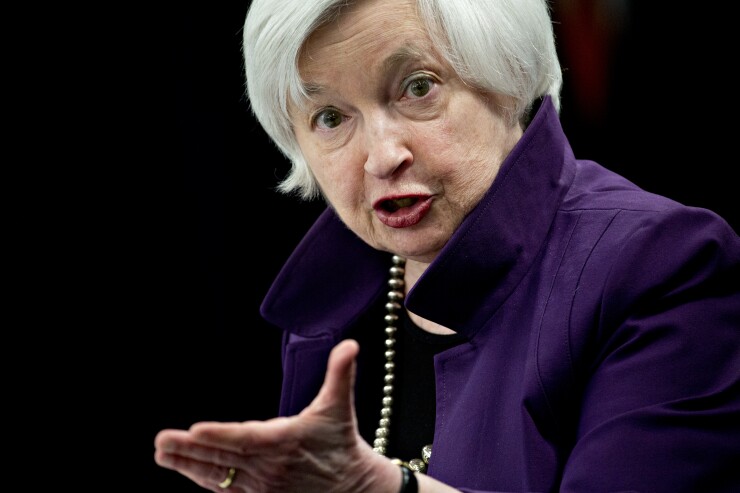WASHINGTON — Federal Reserve Chair Janet Yellen offered limited praise Wednesday for a report issued by the Treasury Department earlier this week that recommends sweeping changes to the post-crisis regulatory framework.
Speaking during a press conference accompanying the meeting of the Fed’s Federal Open Market Committee, Yellen called it a "complicated document" that she has yet to fully review, but suggested that she shared many of its objectives, including reducing regulatory burden without sacrificing safety and soundness.
“It underscores the importance of capital, liquidity, stress testing and resolution planning and having a safe and sound banking system, which are views that I and my colleagues have long espoused,” Yellen said. “Regulatory burden, where it is possible to ease it — and a good deal of the Treasury report is focused on regulatory burden — is something that all regulators should be looking to do.”

Yellen said the agency has already been working to tailor its regulatory requirements to best fit the size and complexity of the financial institutions it regulates, a clear goal of the Treasury report. She also shared some of the critical views expressed about the Volcker Rule and its complexity, noting that she was heartened that the report still supported some limits on proprietary trading, which was at the heart of the rule.
“There are a number of areas where our thinking aligns,” Yellen said. “There are likely some areas where we are likely to have differences, but there are a number of areas where we … are already taking actions that are consistent with those recommendations.”
But she made it clear there were areas of disagreement as well. The Treasury Department on Monday issued a much-anticipated
The report strongly criticized bank regulators’ implementations of international capital standards, particularly those associated with the Basel III accords, including the risk-based
The Treasury report also indicated that regulatory burden was making an impact on banks’ ability to lend, suggesting that capital and other rules were keeping down not only the banking industry but economic growth more generally.
“There is some indication that the supply of credit in key areas of the economy is significantly curtailed due to regulatory restrictions,” the Treasury report said. “Regulatory requirements have increased the costs of providing services to consumers, steered lenders away from certain forms of lending, and otherwise impeded the efficient allocation of credit with improperly tailored regulation.”
Yellen appeared to take exception to that conclusion, echoing earlier comments that she felt there was little conclusion to be drawn between post-crisis regulation and whatever difficulties banks may be experiencing in making loans.
“I don’t think that our regulations have played an important role, at least broadly speaking, in impeding credit growth and the growth of the economy,” Yellen said. “I think when banks are undercapitalized and weak, that impedes credit growth, and when banks are strong they are in a much better position to lend.”
Yellen’s comments came as the Federal Open Market Committee raised the federal funds rate 0.25%, marking the third rate hike in a row since December 2016 and bringing baseline interest rates up to between 1-1.25%.
The central bank rate-setting committee also made the announcement that it will finally begin drawing down its balance sheet “this year, provided the economy evolves broadly as anticipated.” The Fed’s balance sheet topped $4.47 trillion in 2016, ramped up by the “quantitative easing” initiatives that followed the financial crisis whereby the Fed bought mortgage-backed securities from ailing banks to secure their balance sheets.
The committee said that, when it begins drawing down its balance sheet, it will start at a rate of $6 billion a month, increasing by $6 billion every three months until the rate reaches $30 billion.
The Fed expects to reduce its balance sheet until it reaches a level “appreciably below that seen in recent years but larger than before the financial crisis; the level will reflect the banking system’s demand for reserve balances and the committee’s decisions about how to implement monetary policy most efficiently and effectively in the future.”
Wednesday’s rate increase came in spite of some lower projections for inflation, with the committee seeing a core inflation rate for the year of roughly 1.7% and a personal consumption expenditure inflation rate — that is, inflation minus costs for food and fuel — at 1.6%.
The committee had projected both rates at 1.9% in March — closer to its long-stated 2% inflation target. The committee said that it expects inflation to “remain somewhat below 2% in the near term but to stabilize around the committee’s 2% objective over the medium term.”



